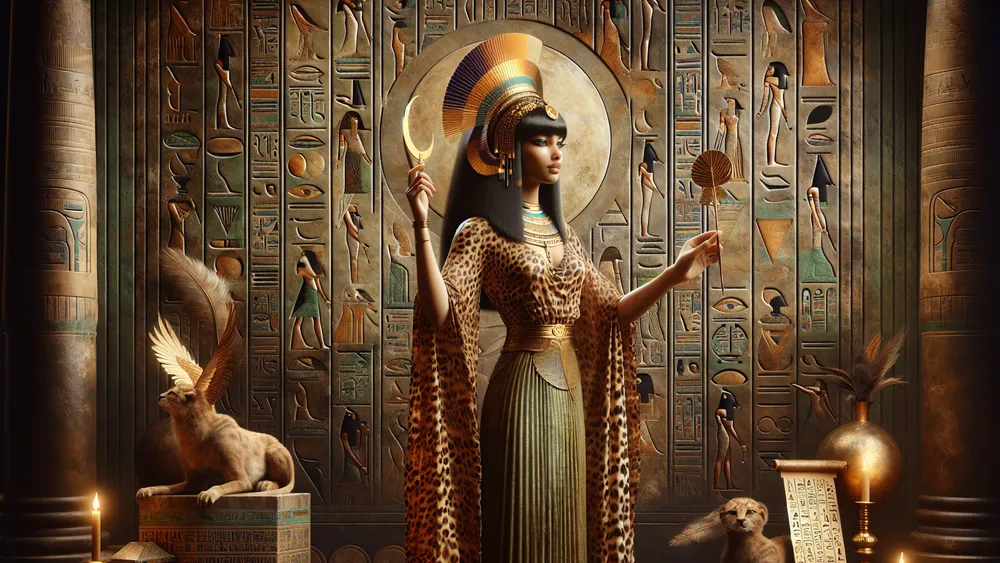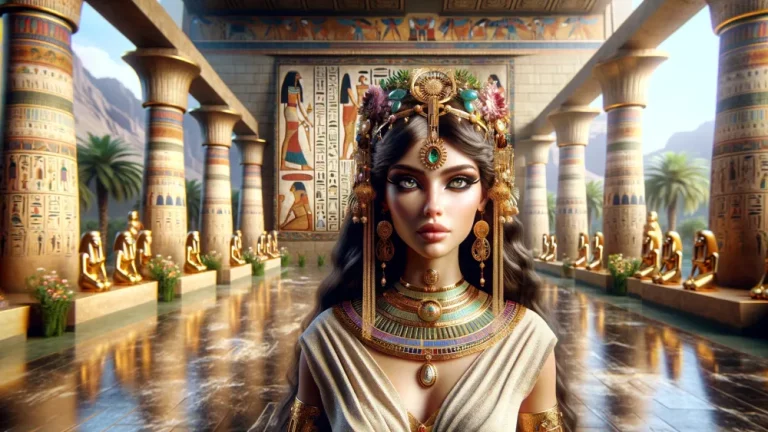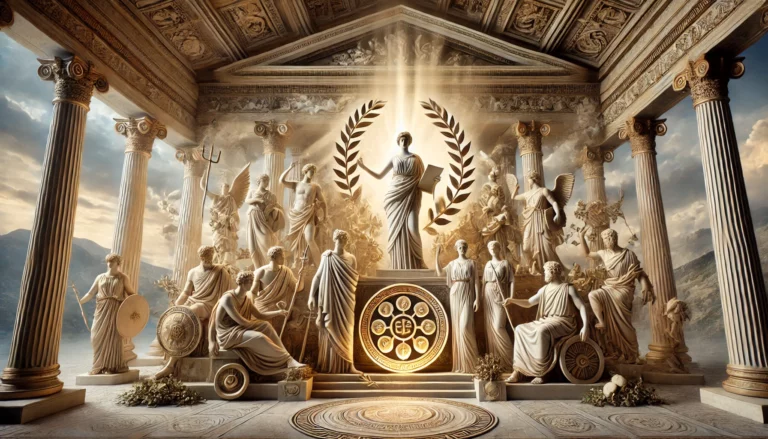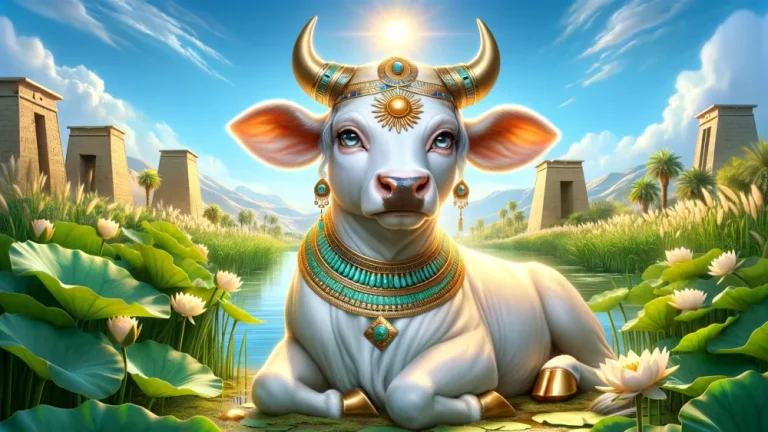Seshat: Egyptian Goddess Of Writing And Wisdom
Seshat, the ancient Egyptian goddess of writing and wisdom, is a fascinating figure. She’s not just a scribe; she’s a keeper of knowledge. People venerate her for her role in developing writing, record-keeping, and education. As Thoth’s divine counterpart, she’s more than just a documenter. She’s woven into the very fabric of ancient Egyptian culture.
Key Points:
- Seshat is the Egyptian goddess of writing, knowledge, and wisdom.
- She is linked to Thoth, Ra, and Ma’at in Egyptian mythology.
- Seshat is credited with inventiwriting and record-keeping.
- She plays a crucial role in education and architecture.
- Seshat’s symbols include a leopard-skin dress and a seven-point star.
- People in ancient Egypt worshipped Seshat through rituals and offerings.
- Seshat and Thoth work together in writing and knowledge, promoting intellectual and practical pursuits.
Her influence touches everything from architecture to administration. This blog post dives into her origins, roles, symbols, and cultural impact. We aim to shed light on her lasting legacy, both in ancient times and today.
Origins of Seshat
To really get who Seshat is, we need to peek into her beginnings and see where she stands among the gods. So, let’s jump into her story and discover how she fits into the divine family.
Birth and Family
Seshat’s story starts with her roots in ancient Egyptian mythology. Many believe she’s the daughter of Thoth, the god of wisdom and writing. Some myths even say she might be his consort. This link to Thoth shows her deep connection to knowledge and writing.
She’s also tied to other gods, like Ra, the sun god, and Ma’at, the goddess of truth and justice. These connections make her a key figure in keeping the cosmic order. In the Egyptian pantheon, Seshat stands out as the goddess of writing, measurement, and architecture. She’s crucial to both the gods and humans.

- Parentage and Lineage: Often considered Thoth’s daughter or consort.
- Connection to Other Deities: Linked to Ra and Ma’at.
- Role in Divine Family: Integral in maintaining cosmic order.
- Place in Pantheon: Goddess of writing, measurement, and architecture.
Seshat’s significance lies in her ties to Thoth, Ra, and Ma’at, which establish her as a vital figure in maintaining cosmic order and as the goddess of writing, measurement, and architecture.
Roles and Responsibilities
So, we’ve got a handle on Seshat’s origins. Now, let’s dive into what she actually does. Her roles and responsibilities are super intriguing and worth exploring.
Goddess of Writing and Knowledge
Seshat holds a special place as the goddess of writing in ancient Egyptian mythology. She’s the one who comes up with writing and record-keeping, making her the go-to deity for scribes and scholars. But she doesn’t stop there. Seshat is also all about knowledge and wisdom.
She plays a big part in education and learning, leaving her mark on ancient Egyptian literature and science. Her role ensures that knowledge gets preserved and passed down, which is super important for the intellectual and cultural growth of ancient Egypt.
- Invention of Writing: Credited with creating writing and record-keeping.
- Patroness of Scribes: Protector and guide for scribes and scholars.
- Education Contributions: Major influence on learning and education.
- Impact on Literature and Science: Significant role in the development of Egyptian literature and scientific knowledge.
Measurement and Architecture
Seshat has a big role when it comes to measurement, especially in surveying and geometry. She’s the one who helps with measuring land and laying out building plans, which is super important for construction and architecture. Her contributions really stand out in building projects, like temples and pyramids. Seshat makes sure these structures are not only functional but also carry deep symbolic meaning.
You often see her symbols in architectural designs, showing her divine authority over measurement and order.

| Aspect | Details |
|---|---|
| Surveying and Geometry | Seshat assists in measuring land and creating building plans. |
| Construction Importance | Key figure in ensuring accurate construction and architectural designs. |
| Temple Construction | Active role in the planning and building of temples. |
| Pyramid Construction | Involved in the precise layout and construction of pyramids. |
| Symbolism | Architectural designs often include symbols representing her authority. |
Iconography and Symbols
Alright, now let’s dive into how Seshat shows up in ancient art and what her unique symbols really mean.
Depiction in Ancient Art
In ancient Egyptian art, Seshat often shows up with some pretty distinct features. You usually see her wearing a leopard-skin dress, which ties to her role in rituals. On her head, there’s a seven-pointed star, a symbol that’s all about her divine wisdom. She also holds a palm rib, which stands for time and record-keeping. These symbols aren’t just for show; they highlight her authority over writing, measurement, and knowledge.

The seven-pointed star points to her celestial connection, while the palm rib underscores her job in documenting events and keeping things in order.
- Leopard-skin dress: Signifies her role in rituals.
- Seven-pointed star: Symbolizes her celestial connection and wisdom.
- Palm rib: Represents time and record-keeping.
Seshat’s distinct features in ancient Egyptian art symbolize her authority over writing, measurement, and knowledge, tying to her role in rituals and emphasizing her celestial and timekeeping connections.
Worship and Cultural Influence
Alright, let’s dive into how folks honored Seshat and what kind of mark she left on ancient Egyptian culture.
Worship Practices and Rituals
People in ancient Egypt had various ways to venerate Seshat. They built temples and shrines just for her, where they performed special rituals and ceremonies. These practices often included offerings and prayers, hoping to get her blessings for knowledge and good record-keeping. But her influence didn’t stop there. Seshat played a big role in education and administration too.

She was key in training scribes and managing state affairs. Even today, her legacy lives on in modern interpretations of Egyptian mythology, where she still stands for wisdom and learning.
Seshat was venerated in ancient Egypt through temples and shrines, where rituals and ceremonies were performed for her blessings in knowledge and record-keeping, and she also influenced education and administration by training scribes and managing state affairs, with her legacy remaining relevant in modern interpretations of Egyptian mythology for wisdom and learning.
Seshat’s Association with Thoth
Alright, let’s jump into the special bond between Seshat and Thoth.
Thoth and Seshat: The Sacred Scribes
Thoth and Seshat have a special bond in Egyptian mythology. They often work together in writing and knowledge. Thoth, the god of wisdom and writing, teams up with Seshat, the goddess of writing and measurement. You see them in many mythological stories where they record important events and keep cosmic order. Their joint efforts really push the development of writing in ancient Egypt.

The partnership between Thoth and Seshat shows the harmony between intellectual pursuits and practical applications, making them key figures in Egyptian mythology.
Pantheon of All Egyptian Mythology Gods
Want to explore more about Egyptian deities? Check out this list of all the Egyptian gods. It covers all the major ones and gives you a great overview.
FAQs
1. Who Was Seshat In Egyptian Mythology?
Seshat in Egyptian mythology was the goddess of writing, knowledge, and wisdom.
2. What Was Seshat’s Role In The Egyptian Pantheon?
Seshat’s role in the Egyptian pantheon was primarily as the goddess of writing, knowledge, and measurement.
3. How Was Seshat Depictured In Ancient Egyptian Art?
How Seshat was depicted in ancient Egyptian art often included her wearing a leopard skin dress and a headdress featuring a seven-pointed star above a downturned crescent.
4. What Is The Significance Of Seshat’s Relationship With Thoth?
The significance of Seshat’s relationship with Thoth lies in their collaborative roles in writing and knowledge, symbolizing the unity of intellectual and creative pursuits in Egyptian mythology.







